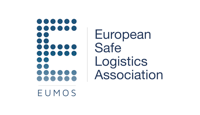Read it in German? Click here.
EUMOS was a guest of the Austrian Economic Chambers [Wirtschaftskammer Österreich] for the first time in 2015. The international EUMOS symposium, which was brought into being in 2012 by Wolfgang Neumann/EUROSAFE GmbH, has successfully established and proven itself as the top event for industry in Europe on the subject of cargo securing, packing of load units and vehicle technology.
The event was able to repeat the success of 2014 (symposium in Brussels) with over 120 participants from more than 20 countries – including the United States and Asian countries.
 The European association of experts, EUMOS, began its work seven years ago with a small group of experts in Germany, Austria and Switzerland. At that time in Europe, the subject of cargo securing had already been much discussed – particularly in the context of the new European standard 12195-1. The EUMOS association, which established its headquarters in Brussels three years ago, has repeatedly expressed its support but has also worked on practice-oriented solutions. The European experts therefore put all of their energy into creating standards, which – building on the packaging – lead to optimal form-lock loading through the creation of load units. At EUMOS, we were therefore initially able to devote less attention to friction-lock loading.
The European association of experts, EUMOS, began its work seven years ago with a small group of experts in Germany, Austria and Switzerland. At that time in Europe, the subject of cargo securing had already been much discussed – particularly in the context of the new European standard 12195-1. The EUMOS association, which established its headquarters in Brussels three years ago, has repeatedly expressed its support but has also worked on practice-oriented solutions. The European experts therefore put all of their energy into creating standards, which – building on the packaging – lead to optimal form-lock loading through the creation of load units. At EUMOS, we were therefore initially able to devote less attention to friction-lock loading.
In 2014, two EUMOS standards were submitted to the European Commission, which immediately led to a standards mandate by the European Commission. This means that the European Commission immediately incorporated the largely mature technical content of these first EUMOS standards into the work on EU directives. However, these standards are subject to inspection and it cannot be ruled out that even existing standards will be optimised within the framework of worldwide application.
The two EUMOS test standards for the stability of load units (load unit rigidity) and for steel posts (mounted poles) are already being applied throughout Europe since 2012. They are enjoying great popularity because, for the first time, it is possible to conduct a reproducible assessment using these standards and, from a testing perspective, there is a measurable result for packaging stability and cargo securing in vehicle dynamics investigations. The investigation by horizontal testing systems thus very realistically simulates the dynamic behaviour of load units on a road vehicle. Therefore, both the simulated change of load and the simulated acceleration cycles are realistic and can also be reproduced.
The use of recognized test methods, which in the meantime are used in the whole of Europe and also in Asia, mean that it has been possible to at least avoid damage, and perhaps also accidents. In the meantime, EUMOS has received information that the United States and Australia would also like to align themselves to these standards.
Redefinition of the requirements to be a “qualified expert”
EUMOS redefined the minimum requirements for experts in Europe. The aim is to ensure that trainers and consultants are, as far as possible, qualified and certified to a uniform level throughout Europe.
In terms of content, it is not only road transport that is given consideration but also international road, rail, ferry and sea transport – and a combination thereof. On top of this, specialist knowledge in the area of packaging is required and is fundamental for safe transport.
To ensure quality, the new minimum requirements go one step further in that they stipulate that the trainers enjoy broad training and must fulfil certain approval requirements as well as undergo regular monitoring by a certification company accredited in Europe. Companies that have their employees trained according to EUMOS can therefore be certain that only impartial trainers operate at the required and certified high level.
In the past three years, over 70 people throughout Europe have already completed their training according to this content. People who receive the certification demonstrate that they have a broad range of knowledge in land and sea transport and must also be personally suitable for the tasks of a qualified expert. Misuse of titles leads to serious consequences. Therefore, people who have repeatedly written flawed reports or have strayed from the path of impartiality may also lose their title again.
The industry must be able to rely on a high level of practice-oriented expert knowledge as well as on the impartiality of trainers and consultants. In Germany, this is already regulated by the approval of publicly appointed and sworn experts by the chambers of industry and commerce. For trainers and consultants, EUMOS has already established a system for Europe that works well and it will continue to develop it.
There is also a new training plan that stipulates the minimum requirements for the training of hauliers EU-wide in accordance with EUMOS standard 40607-1. Approved training companies in Europe are now offering this training in German, English and French.
As soon as trainers have qualified via a certification body that has been approved by EUMOS and accredited (for example by DAkkS in Germany), they can apply to be included in the EUMOS register of trainers (info@eumos.eu). The relevant certificates must be submitted for this.
Additional new standards for Europe/Testing of the tensile strength of stretch films
From 2016 onwards, there will be further EUMOS standards, which can already be partly retrieved from the Belgian Bureau for Standardisation (NBN). For example, test methods were developed for the pre-stretching of stretch film on load units. Further standards are already being drawn up by “technical committees” or are already available.
Allow yourself to be surprised about further developments at EUMOS. Be involved in the practice-based drawing up of industry standards in the area of transport security and become a member. EUMOS focuses on the everyday tasks that arise in practice in relation to the topics of packaging, load unit formation and cargo securing.
EUMOS SAFETY AWARDS bestowed for the first time
 EUMOS received a whole host of applications and suggestions for the awarding of the four EUMOS SAFETY AWARDS. A series of personal achievements and technical innovations were nominated. However, this time consideration was given only to people or institutions who by their particular accomplishments made a substantial contribution to supporting EUMOS themes.
EUMOS received a whole host of applications and suggestions for the awarding of the four EUMOS SAFETY AWARDS. A series of personal achievements and technical innovations were nominated. However, this time consideration was given only to people or institutions who by their particular accomplishments made a substantial contribution to supporting EUMOS themes.
Professor Ulrich Podzuweit was honoured for his life’s work in the areas of cargo securing and automotive engineering and the resulting scientific findings derived from this over the years. For more than 20 years now, Professor Podzuweit has done valuable groundwork for cargo securing in Germany, including for the German Federal Ministry of Transport, and, following on from this, also for Europe.
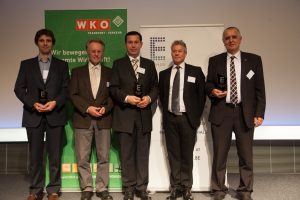
Captain Anatoly Shmelev received an award for his many years of extraordinary work in Belarus. By his untiring dedication over the past 25 years, captain Shmelev introduced the topics of cargo securing and packaging to Eastern Europe, Belarus and Russia.
The Austrian Economic Chambers [Wirtschaftskammer Österreich], represented by Mr Alexander Klascka and Dr Stefan Ebner (EUMOS member), merged the topics of cargo securing and packing together in Austria within one year. This gave enormous impetus to giving further consideration to the responsibilities of the driver and the haulier. An EUMOS SAFETY AWARD was bestowed by EUMOS president Wolfgang Neumann for this also.
Ing. Jelle Dendauw received an award for his work on load unit stability. Ing. Dendauw is CEO of ESTL NV, a high tech solution provider for transport packaging. ESTL is worldwide the major supplier of test equipment for measurements according to Eumos 40509 and numerous other test and measurement equipment related to transport packaging, stretch wrap film, packaging performance, friction measurement, … The ESTL test lab in Deerlijk (Belgium) is probably the most sophisticated in its kind and is highly appreciated for its customer orientation approach.
Mr. Dendauw receives this award for his know-how on stretch wrap film, stretch film wrappers and load unit stability. This know-how is revealed in several patents and a world-wide customer base. He is a dedicated Eumos expert member since 2011.
Address of the representative of the European Commission, policy officer Ms Emese Vida, DG MOVE C.4 – Road Safety Unit
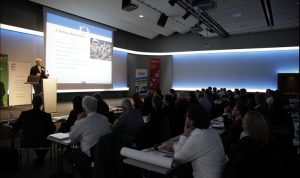 The objective of the European Commission is to constantly come closer to the vision of zero accidents. The downward trend in fatal accidents in Europe is already clearly recognisable and was recorded by Ms. Vida. Nevertheless, each fatal accident is still one too many. It is therefore important to pursue a common strategy for Europe. The efforts of EUMOS are an important step in the right direction to reduce hazards from the outset.
The objective of the European Commission is to constantly come closer to the vision of zero accidents. The downward trend in fatal accidents in Europe is already clearly recognisable and was recorded by Ms. Vida. Nevertheless, each fatal accident is still one too many. It is therefore important to pursue a common strategy for Europe. The efforts of EUMOS are an important step in the right direction to reduce hazards from the outset.
Important steps for achieving these targets are:
- Apprenticeship and professional training
- Standardisation of traffic rules
- Safe road infrastructure
- Safe transport vehicles
- Intelligent transport systems
- Emergency assistance and support
- Reduction of endangerment of transport users
Targets and developments in Austria – Mr Alexander Klascka , Chairman of the Transport and Traffic federal sector, Austrian Economic Chambers
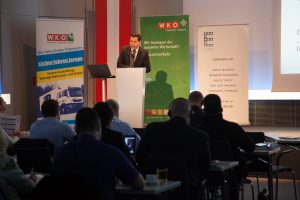
The manufacturing sector is becoming digitally networked on a global scale (Industry 4.0). Division of labour, real-time information and online services require logistics to be more flexible in terms of supply chains, transport options and the size of containers. Equality of competition in Europe is a fundamental political objective here. Uniform standardisation, for example through the efforts of EUMOS …
Developments in Poland – Ms Katarzyna Piechowska-Strumik, General Inspectorate of Road Transport, Poland
The introduction of technical roadside inspections pursuant to EU Directive 2014/47/EU meant that the topic could finally be integrated into official inspections for Poland. This addressing of the topic is leading to lasting change in cargo securing in Poland. The stability of load units plays a fundamental role and, to date, had only been given cursory consideration by hauliers in Poland.
Legal opinion in Austria – Dr. Bernhard Haid
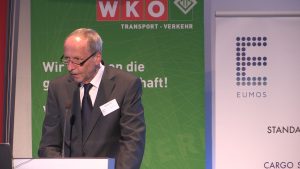 “For trans-European transport networks to function well, they require common rules and a high degree of recognition”, says Dr Bernhard Haid, lawyer, Austria. The EUMOS approaches are therefore precisely what Europe needs. We will not achieve any acceptable solutions by having individual regulations. An important point is therefore also the ability to hold the driver and the haulier accountable – particularly if the packaging is defective.
“For trans-European transport networks to function well, they require common rules and a high degree of recognition”, says Dr Bernhard Haid, lawyer, Austria. The EUMOS approaches are therefore precisely what Europe needs. We will not achieve any acceptable solutions by having individual regulations. An important point is therefore also the ability to hold the driver and the haulier accountable – particularly if the packaging is defective.
“Transport packaging” session

The inspection and the resulting optimisation of transport packaging (unit loads) and the performance capacity of high-performance films were presented by Mr Jelle Dendauw/ESTL and Ms Adeline Duponchel from ExxonMobil. The formation of load units made of paper and PE bags is a Europe-wide topic. This and the resulting measures to improve load unit stability were explained in detail and impressively by Dr Lennart Ederleh from Windmöller & Hölscher.
“Transport safety” session
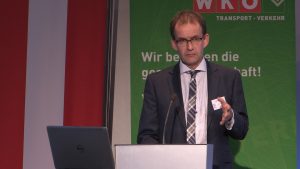 Best practices dominated this block of lectures, which on its own could have taken up one day. However, Mr Marc Twist from the ECTA transport association demonstrated the requirements for a safe loading and unloading process. Because drivers in Europe will only be able to intervene in cargo securing to a limited extent in the future, the requirements for quick and secure loading and unloading must be complied with. “Are you already driving or are you still lashing?”. That is the motto of Mr Gerd Labinsky from Evonik. Optimised vehicle equipment means that load units can be handled significantly more easily in the loading process. Carriers such as EWALS Cargo Care also gave innovation a real boost here with their new trailer technology. Mr Bart van Rens (Manager Fleet Control and certified trainer and consultant) showed the success of his customers and how satisfied they were. Mr Holger Lemmer (TISPOL) and Mr Martin Malits (police officers from Germany and Austria) shared their experiences as policemen.
Best practices dominated this block of lectures, which on its own could have taken up one day. However, Mr Marc Twist from the ECTA transport association demonstrated the requirements for a safe loading and unloading process. Because drivers in Europe will only be able to intervene in cargo securing to a limited extent in the future, the requirements for quick and secure loading and unloading must be complied with. “Are you already driving or are you still lashing?”. That is the motto of Mr Gerd Labinsky from Evonik. Optimised vehicle equipment means that load units can be handled significantly more easily in the loading process. Carriers such as EWALS Cargo Care also gave innovation a real boost here with their new trailer technology. Mr Bart van Rens (Manager Fleet Control and certified trainer and consultant) showed the success of his customers and how satisfied they were. Mr Holger Lemmer (TISPOL) and Mr Martin Malits (police officers from Germany and Austria) shared their experiences as policemen.
“New in the area of load safety” session

The interconnection of packaging, load units and cargo securing necessarily leads to an optimisation of process costs. It may well be the case that there are increased costs for load units, but the turnover rate and safety increase as a result – according to Dr Stefan Ebner from the Austrian Economic Chambers. Training of drivers in the area of cargo securing, in Austria but also generally in Europe, must continue to be improved. However, trainers also cannot stand still. Nowadays, it is no longer sufficient to hand out some formula or other to participants. We need to inspire people who are involved in cargo securing and must not fob them off with banalities. This is where integrative EUMOS training programs from road, rail and sea transport come into their own. “We are finally close to what’s happening in practice”, says Mr Reinhard Koller from Cargo Safety. It is truly shocking that the practical element can in general hardly be measured – even in what appear to be professional training courses. One-off qualifications are also to be viewed very critically. It is no wonder that there is an unacceptable proliferation of trainers in light of the lack of monitoring. Therefore, one is well-advised to pay particular attention to the qualifications of trainers nowadays. The best way to recognise this is to ask the trainer in the seminar, not just for his qualifications, but also for a binding practical solution for which he would also take personal responsibility.
New findings in containers
 Lashing points in containers are great. Only: What do they hold? Also here, the guidelines stipulate figures that represent minimum values. However, there is as yet no answer to the question of what actual procedures should be followed when using lashing points. Professor Axel Krapoth carried out an initial research assignment in this area – and found sobering results. The examination of the topic of cargo securing in containers is still largely in its infancy and knowledge on the topic is not yet sufficiently widespread. According to the professor for technical mechanics, the information in the relevant literature can be described as “dangerous” or also fundamentally incorrect. It is a matter of urgency that greater clarity be provided here. It is absurd to live just by the assumptions and accounts of business-minded suppliers. Clarity can be worked out in practice, but also in theory. A finite element calculation clearly shows that lashing points with today’s weld seams simply have their limits and the restraint systems (lashing systems) on the market definitely have a high performance capacity. The performance figures are higher than, for example, cargo securing with timber.
Lashing points in containers are great. Only: What do they hold? Also here, the guidelines stipulate figures that represent minimum values. However, there is as yet no answer to the question of what actual procedures should be followed when using lashing points. Professor Axel Krapoth carried out an initial research assignment in this area – and found sobering results. The examination of the topic of cargo securing in containers is still largely in its infancy and knowledge on the topic is not yet sufficiently widespread. According to the professor for technical mechanics, the information in the relevant literature can be described as “dangerous” or also fundamentally incorrect. It is a matter of urgency that greater clarity be provided here. It is absurd to live just by the assumptions and accounts of business-minded suppliers. Clarity can be worked out in practice, but also in theory. A finite element calculation clearly shows that lashing points with today’s weld seams simply have their limits and the restraint systems (lashing systems) on the market definitely have a high performance capacity. The performance figures are higher than, for example, cargo securing with timber.
“Innovative cargo securing methods” session

The new container restraint system from Cordstrap was a real innovation. Mr David Parrin was able to quickly convince participants with his authoritative style and great rhetorical skills. The products of the cargo company Forankra also come into play here, as they make it easier for users to implement cargo securing with small but clever innovations.
Mr Stuart Roberts, Executive Director of Sealed Air, demonstrated what you can create today with packaging. Models and simulations as well as the creation of packaging on high-performance computers made it clear that we are actually still at the beginning. We start to secure cargo when it is in front of the HGV or container. Why don’t we start already during product production? Success could be attained significantly more quickly for everybody if that were the case.
“Stretching/Shrinking” session
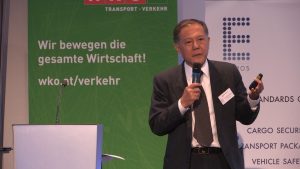 What should be done when manufacturers are making new investments? What should they choose? A stretch-wrap system or a thermal shrink process? How do the packaging and the load unit behave while being transported? These are questions that were dealt with in the presentations by speakers from Greece (Dr Skouras/Maillis), Italy (Dr Aureli/Aetna Group) and Spain (Mr Juan Alcaraz/Itene). Audience members were able to consider and discuss the topic of load unit formation at a high technical level – which is certainly a benchmark worldwide. A comparison of Europe and Asia in terms of the quality of the formation of load units, as explained by Mr PK Ang, Executive Director Thon Guan Industries/Malaysia, clarified this.
What should be done when manufacturers are making new investments? What should they choose? A stretch-wrap system or a thermal shrink process? How do the packaging and the load unit behave while being transported? These are questions that were dealt with in the presentations by speakers from Greece (Dr Skouras/Maillis), Italy (Dr Aureli/Aetna Group) and Spain (Mr Juan Alcaraz/Itene). Audience members were able to consider and discuss the topic of load unit formation at a high technical level – which is certainly a benchmark worldwide. A comparison of Europe and Asia in terms of the quality of the formation of load units, as explained by Mr PK Ang, Executive Director Thon Guan Industries/Malaysia, clarified this.
Conclusion
The symposium of European experts not only provided many high-level contributions, but also, above all, demonstrated that there is a very strong shared understanding throughout Europe of the importance of the topic of transport safety. This is a completely new approach that is not just reduced to the topic of cargo securing, but instead already starts during production processes and packaging. However, the training of trainers and employees must also drastically change so that people – who are at the centre of what we do – know exactly what they have to do to avoid hazards.
When will the next convention take place? A lot of people asked this after the event had finished. We will see!
Kind regards, Wolfgang Neumann
